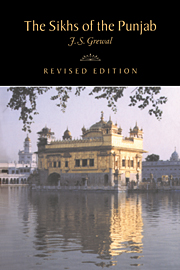Book contents
- Frontmatter
- Introduction
- 1 The Turko-Afghan Rule
- 2 Foundation of the Sikh Panth
- 3 Evolution of the Sikh Panth (1539–1606)
- 4 Transformation of the Sikh Panth (1606–1708)
- 5 Rise to political power (1708–1799)
- 6 The Sikh empire (1799–1849)
- 7 Recession and resurgence (1849–1919)
- 8 In the struggle for freedom (1920–1947)
- 9 Towards the ‘Punjabi Province’ (1947–1966)
- 10 In the new Punjab state (1966–1984)
- Bibliographical essay
- Index
- THE NEW CAMBRIDGE HISTORY OF INDIA
- References
4 - Transformation of the Sikh Panth (1606–1708)
Published online by Cambridge University Press: 28 March 2008
- Frontmatter
- Introduction
- 1 The Turko-Afghan Rule
- 2 Foundation of the Sikh Panth
- 3 Evolution of the Sikh Panth (1539–1606)
- 4 Transformation of the Sikh Panth (1606–1708)
- 5 Rise to political power (1708–1799)
- 6 The Sikh empire (1799–1849)
- 7 Recession and resurgence (1849–1919)
- 8 In the struggle for freedom (1920–1947)
- 9 Towards the ‘Punjabi Province’ (1947–1966)
- 10 In the new Punjab state (1966–1984)
- Bibliographical essay
- Index
- THE NEW CAMBRIDGE HISTORY OF INDIA
- References
Summary
During the seventeenth century five Gurus succeeded Guru Arjan. His son, Guru Hargobind was succeeded by a grandson, Guru Har Rai. The younger son of Guru Har Rai, Guru Har Krishan was succeeded by a grand uncle, Guru Tegh Bahadur, the youngest son of Guru Hargobind. Guru Gobind Singh, who succeeded his father Guru Tegh Bahadur in 1675, abolished personal Guruship before his death in 1708.
Interference by the Mughal emperors Jahangir, Shah Jahan and Aurangzeb in the affairs of the Sikh Panth was an important feature of this period. We have already referred to the martyrdom of Guru Arjan at the beginning of Jahangir's rule. A few years later, Jahangir ordered the detention of Guru Hargobind in the fort of Gwalior which was generally used for detaining political prisoners. In the reign of Shah Jahan the Mughal administrators of the Punjab came into armed conflict with Guru Hargobind. Aurangzeb took an active interest in the issue of succession, passed orders for the execution of Guru Tegh Bahadur, and at one time ordered total extirpation of Guru Gobind Singh and his family. State interference was, thus, a serious matter.
State interference encouraged dissent within the Sikh Panth and accentuated disunity. Prithi Chand, significantly, put forth his claim to be the successor of Guru Arjan after his martyrdom, becoming thus a rival of Guru Hargobind. Dhir Mai, a grandson of Guru Hargobind, preferred to remain in the good books of the emperors and chose to have his own centre in the province of Lahore rather than succeeding to the office of Guru Hargobind at his headquarters in a vassal principality.
- Type
- Chapter
- Information
- The Sikhs of the Punjab , pp. 62 - 81Publisher: Cambridge University PressPrint publication year: 1991



